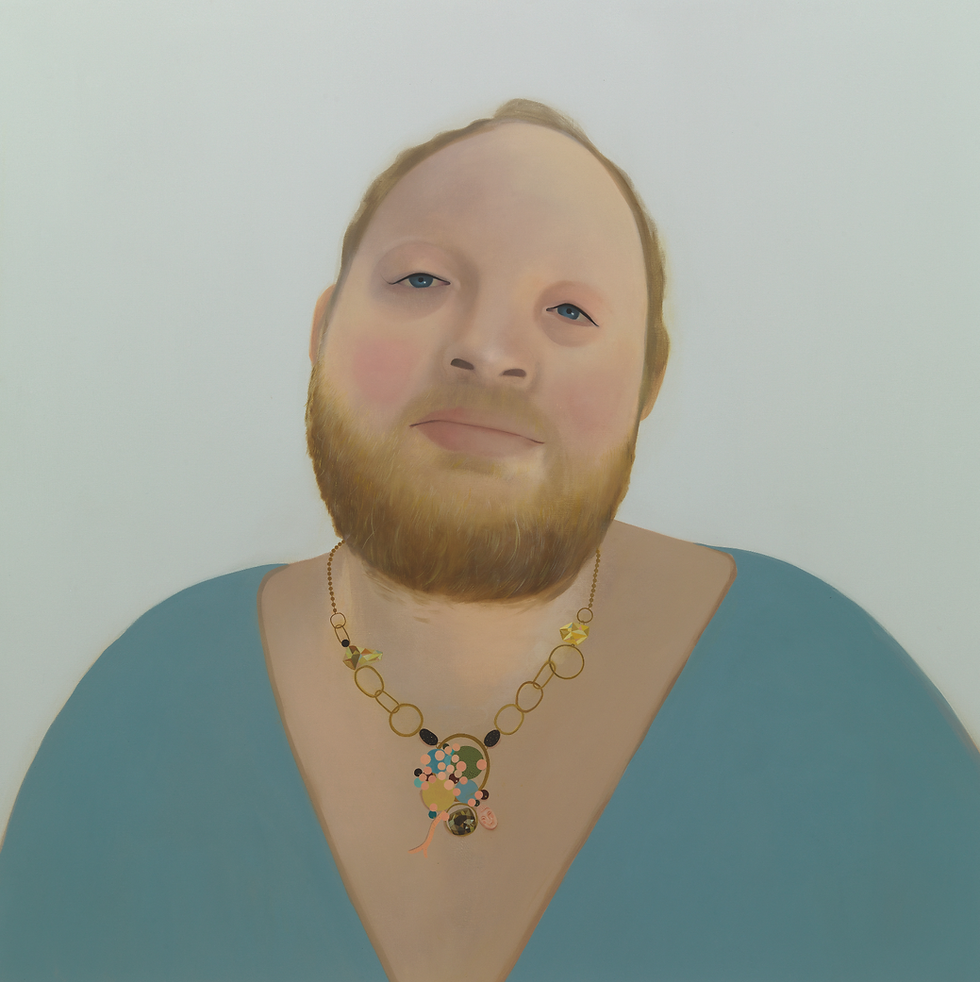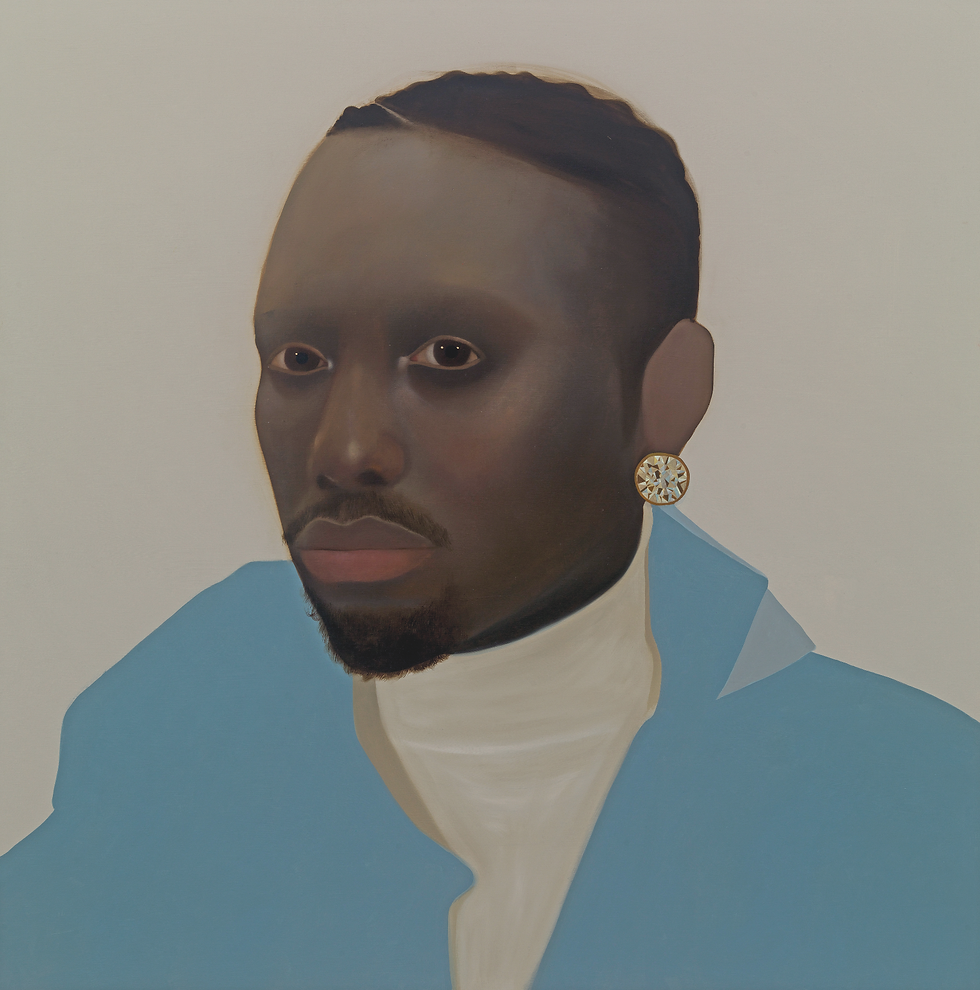Words by Martin Holman
Sarah Ball’s extraordinary ordinary people.

Encountering the face of Masha for the first time in Sarah Ball’s painting, the question arises: who is Masha? That reaction is perfectly natural. After all, her presence is striking. Moreover, the picture will soon be seen in a prominent London art dealer’s gallery, itself a rare distinction. Her head with its placid features is modelled in oil on a canvas that measures over four feet in height and width. Size often denotes importance, especially in art, which has devoted immense spaces in the past to depictions of battles, the Bible, the rich and famous. By contrast, Masha arrives without a story, just her clear skin tones placed dramatically against a background darkening into deep greenish grey, and her head in a scarf with that elegant ring piercing her nose.

Masha is an enigma – and there is no guarantee even that her name is genuine. She might be a future star of the music business or someone seen in the street. Indeed, she could be both. But the viewer has nothing reliable to go on except for what is seen in this young woman’s appearance. That dependence on personal assessment is part of the fascination of this captivating image. The same goes for Ball’s intriguingly fresh approach to an ancient type of painting, for the art of portraiture is perhaps the most searching, critical and revelatory of genres. However, in the age of the camera and the instant selfie, it seldom causes a stir. This artist, however, helps endow portrait painting with its contemporary relevance.
More is known about Sarah Ball than her subjects. Born in south Yorkshire, she attended art school in Wales and Bath, and has been based in west Cornwall for several years. After working as an illustrator, she turned to painting and had the first of five one-person exhibitions in 2012 in St Ives at Anima Mundi gallery, which supported her early career and introduced her distinctive method of research and depiction to the gallery-going public. Since then, Ball’s work has been included twice in the summer exhibition at the Royal Academy of Arts in London and last year was featured in the prestigious Frieze art fair in New York. That overseas exposure built on shows in Texas and Ireland, and now she is preparing to open her first solo presentation at Stephen Friedman Gallery in London’s West End.

That progress reflects the growing critical interest in how she constructs a portrait from some unorthodox elements. Her canvases are not found in company boardrooms or lining college staircases. Indeed, Ball has never met the people in her paintings. Instead, she has trawled historical archives, the pages of magazines and the Internet to find the faces that interest her. Would, then, her subjects be surprised to come across themselves hanging on the wall of an art gallery? Until recently, the chances of that happening were very slim. The reason is that many of those people lived 50 or a 100 years ago, a fact that itself contributes to the lure of these painted likenesses. Ball selected them from official records, such as at the huge Ellis Island immigration centre in New York harbour. Over 12 million migrants to the United States were processed there during the 50 years from 1892. Each new arrival was photographed and his or her details filed.
Not surprisingly the documentation was immense and supplied Ball with an entire show of paintings, called Immigrants, which took place in St Ives in 2015. Wood panels, then not much larger than the photographs Ball researched, were prepared with a smooth surface of gesso upon which oil paint infused these heads with a luminescence that the black-and-white glass or film negatives in the archives could not capture. In these paintings, the faces acquired colour as if Ball had not only breathed life into them but also restored their humanity, as people who once lived and dressed and walked, who travelled across an ocean in hope to escape poverty or violence, and who were picked out by officials and, perhaps for the first time in their lives, sat waiting for a flash bulb to explode. Then they slipped back into the flow of newcomers, anonymous to history. Over time, their names and origins were lost, leaving only their features and the clothes they sat down in (often their best traditional costume) to posterity.

As the titles of her other exhibitions imply, Ball’s starting point is the labels that society applies to groups within it. For instance, she made three series of paintings called Accused (2012-14). Her source was the collection of monochrome mug shots that the US police made mid-last century. Ball used the same pose in each image: a single head with shoulders looking forward into the camera. Many of the offenders were poor, charged with petty crimes like shoplifting and prostitution. Like the immigrants, they occupied a particular category in life from which any community is prone to draw broad assumptions about their characters and social worth. In a sense, they acquired their identity from other people’s opinions and prejudices.
The next series, shown at Anima Mundi in 2017, highlighted one extreme development. It was titled Bertillon after the Paris police officer with family history in statistics who, in the 1880s, devised the technique of human measurement to discover whether criminals could be identified by their physical attributes – especially but not exclusively by the length and breadth of their heads. His theory was debunked decades ago but not before it had been used for years to help convict suspects in many countries on the spurious basis that their features fitted the data. It was a blunt example of primitive ‘character profiling’.
Ball is well aware that this tendency to judge by labels is still around. In 2020, she collaborated with Anima Mundi to raise funds for the campaign against racism and inequality experienced by people of colour after the death of George Floyd in police custody in the US city of Minneapolis. Ball selected three intense portraits featuring the head and shoulders of a black female looking straight out from a plain background at whoever was looking at her. They were made into an edition of prints and offered for sale. The response was immediate. As Anima Mundi’s founder Joe Clarke recalls, the entire edition “sold out within 48 hours raising over £20,000 for Black Lives Matter”.
This artist’s work, whether as drawings, paintings or prints, brings with it no moral schema. Viewer and subject meet on equal terms as strangers do; it might seem that each is sizing up the other. So an intimacy arises that is one privilege offered by an artwork. Looking at Masha again, questions surface about how Ball nurtures the colour tones in the cheeks, and the way shadow shapes the curve of her nose, a nostril or her full lips. Her eyes have a depth and density that is immediately enlivened by the dot of external light reflected in each retina. Then two details mark Masha out as unique: the way she wears her headscarf and that nose piercing.
Ball activates painted imagery to explore individual identity. That quality has seldom been more negotiable and sensitive than today, and partly explains why Ball has used social media as a source since 2019. The criterion for selecting who to paint is always her interest in a face, often because its owner has chosen a style or colour of hair or a quirky body adornment, or strongly displays an attractive attitude. With ‘Anthony’ (2020) it might have been the tilt of his head, caught as if in the spontaneity of a Zoom call, or the chain of interlocking metal shapes that culminates in a pendant of multicoloured beads and stones that Ball records with graphic flourish.
Indeed, she projects delight in the decisions her subjects have taken to present themselves. Ball grew up when glam rock dominated the music charts and artists like David Bowie and Siouxsie Sioux were adopting ambiguous persona that fans, and then fashion, imitated. For some, personal style stood for rebellion against the status quo; for others it offered identification with like-minded enthusiasts; and there were plenty who simply liked the look. Into which category would ‘Michael’ (2021), with his brightly dyed crop, place himself? Ball’s one-person show in 2019 in St Ives reminded visitors with her portrayals that included transgender people from the 1930s, this behaviour is not new. It echoed their desire to be themselves.
The selfie is the latest challenge by photography to the once unsurpassable hegemony of the painted portrait. One painter, when he saw the first daguerreotype 180 years ago, declared “from today, painting is dead.” He was wrong and Ball proves that life remains in the old art. As her paintings have grown in size from small beginnings, the way she paints has become as much her subject as who she paints. Her canvases achieve effects that the camera cannot match: like the contrast between a fringe of hair and the fabric of a jacket, or the visual impression that flat areas recede as plumply modelled details advance. What is more, a painted face hides as much as it reveals once its features are filtered through the artist’s imagination. Some parts might look to have an independent, abstract life of their own, such as the edge of Masha’s scarf as it juts out into a sea of darkness like a promontory of open space.
Ball allows questions to multiply with the freedom of enquiry. Empathy blooms in an era when more and more people struggle to define the identities that suit them. As sensitivities about appearance among adolescents and adults alike are heightened almost to psychological breaking point by the swift exchange of likenesses, the viewer receives as much scrutiny as the sitter in these portraits. The truth, Ball is suggesting, is that anonymity has its benefit – but might be more hoped for than achievable.
Sarah Ball’s solo exhibition at Stephen Friedman Gallery, London (stephenfriedman.com) runs from 28th January to 26th February 2022.

